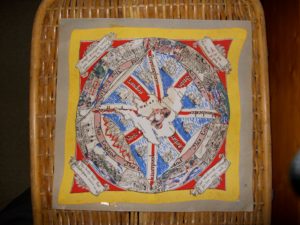To set the scene, we need to travel back in time when limestone formed between 300 and 350 million years ago and Ireland was situated south of the Equator at the bottom of a shallow, tropical sea. Bones and shells of sea creatures, compressed into many layers, became the limestone we can see today at Dunmore Cave.
I recall this cave when researching for places around the Kilkenny area before my recent visit to Ireland. I then forgot about it until en-route to Nenagh, I suddenly saw a sign with the name ‘Dunmore Cave’ in Ballyfoyle.
We pulled off the road into a rather narrow, but long car/coach park which led to the Visitor Centre where there was an exhibition and display area as well as a Tea Room (open daily for July and August).
It is important to point out that the cave is inaccessible to wheelchair users. Toilets do have disabled access.
There were scheduled timing slots where a guide took people into the caves but we had decided to have a hot coffee first, so missed the opportunity. However, we still purchased tickets and were allowed to go down ourselves.
Entry prices are :
Adult – 4 euro
Student – 2e
Senior/Group – 3e
Family – 10e
From information gleaned, it appears the cave has been known for many centuries, since the field above it collapsed. It is first mentioned in the 9th century Irish Triads.
Since 1940 it has been managed by the 0.P.W (The Office of Public Works)
We set out to tackle the 700 steps descending into the cave. At the bottom of the slope there is a ‘Main Hall’ known in local folklore as the ‘fairy floor.’ The series of chambers have formed over millions of years and contains some of the finest calcite formations found in any Irish cave.
It was obviously damp and cold as you descended, although not as bad as I had anticipated. A few children appeared to look upon the experience as quite an adventure, but then I encountered a couple of youngish adults, one of whom wanted to act somewhat recklessly by jumping onto a precarious boulder, fling out his arms and pose for his mate to take a picture!
It was amazing to see at one point, a small area which was penetrated by light, causing a small tuft of green foliage to grow, the marvels of nature!
The cave does have a ‘chilling’ aspect. The Annals tell of a Viking massacre at the cave in the year 928AD. Archaeological finds within the cave confirm Viking activity.
Dunmore contains a quarter of a mile of passages and at its deepest point, it descends to 150 ft. The most spectacular calcite formation is the Market Cross, a distinctly cross-shaped column over 19ft high.
Development as a show cave with visitor centre and tours didn’t begin until 1967, at the behest of respected archaeologist J. C. Coleman. The cave was closed in 2000 for archaeological work and redevelopment before reopening in 2003.
The earliest writings on the cave of an archaeological nature came from George Berkley, a bishop whose report, dated 1706, detailed a visit that he made to the cave as a boy. His essay was not published until 1871.
In 1869, a physician named Arthur Wynne Foot, made an archaeological visit to the cave with Rev. James Graves and Peter Burtchaell. They discovered large quantities of human remains, which they collected. Foot, in his report, documented his findings, and culled references from the writings of researchers over the preceding 120 years.
In 1999, a hoard of 43 silver and bronze items was discovered in a rocky cleft deep in the cave. These consisted of silver, ingots and conical buttons woven from fine silver, dated to 970 AD.
With regard to the Viking massacre of over 1,000 people, it is said that the Vikings from Dublin were en route to attack rival Vikings at Waterford circa 928 AD. They raided surrounding land and found that a large number of people (mainly women and children) were hiding in the cave at Dunmore. Attempting to drive them from the cave, they lit large fires hoping that it would force those taking shelter to flee the smoke so that they could be easily captured and sold in the slave markets. The fires were too large however, and burned all the oxygen in the deep cave, causing many to suffocate.
Antiquarians in the 18th and 19th centuries collected large quantities of human remains from within Dunmore cave, presumably those who were massacred in that raid.
It is said that some Vikings returned to the site later to hide their wealth. In 1999, a small hoard of silver and copper-alloy items was discovered in a cleft deep in Dunmore. The hoard was dated to 970 AD.
Precious objects were found with a luxurious silk garment. The dye that coloured the garment purple was reserved for the highest ranking members of society, and it was derived from the purple murex snail that can only be found on the north coast of Africa, evidence of the incredible trading network of the Vikings. Maybe, the owner of the hoard concealed it there, hoping that the cave’s dark reputation would keep it from prying eyes. Whatever happened, it seems they were never able to return to retrieve it. Or, it is also possible that the Vikings left it as an offering to chthonic (subterranean) gods or spirits?
You Tube has some video footage on exploring the cave if you would like to see more.
As for me, I’m glad we had the opportunity to see Dunmore and learn about its history – certainly worth a visit if in the area.









